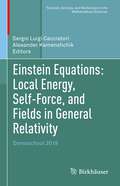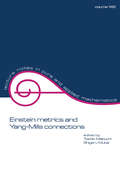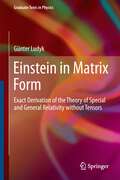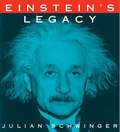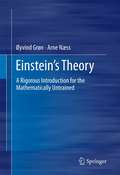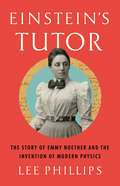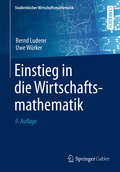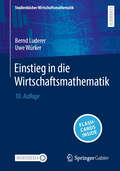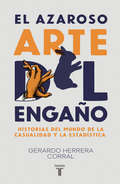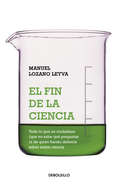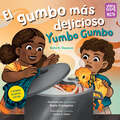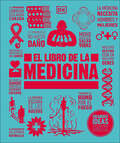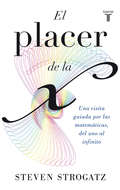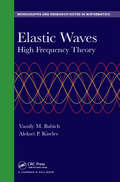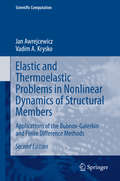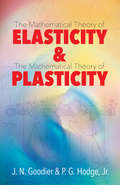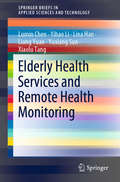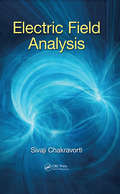- Table View
- List View
Einstein Equations: Domoschool 2019 (Tutorials, Schools, and Workshops in the Mathematical Sciences)
by Sergio Luigi Cacciatori Alexander KamenshchikThis volume guides early-career researchers through recent breakthroughs in mathematics and physics as related to general relativity. Chapters are based on courses and lectures given at the July 2019 Domoschool, International Alpine School in Mathematics and Physics, held in Domodossola, Italy, which was titled “Einstein Equations: Physical and Mathematical Aspects of General Relativity”. Structured in two parts, the first features four courses from prominent experts on topics such as local energy in general relativity, geometry and analysis in black hole spacetimes, and antimatter gravity. The second part features a variety of papers based on talks given at the summer school, including topics like:Quantum ergosphereGeneral relativistic Poynting-Robertson effect modellingNumerical relativityLength-contraction in curved spacetimeClassicality from an inhomogeneous universeEinstein Equations: Local Energy, Self-Force, and Fields in General Relativity will be a valuable resource for students and researchers in mathematics and physicists interested in exploring how their disciplines connect to general relativity.
Einstein Metrics and Yang-Mills Connections: Proceedings Of The 27th Taniguchi International Symposium (Lecture Notes In Pure And Applied Mathematics Ser. #145)
by Toshiki Mabuchi; Shigeru MukaiThis volume contains papers presented at the 27th Taniguchi International Symposium, held in Sanda, Japan - focusing on the study of moduli spaces of various geometric objects such as Einstein metrics, conformal structures, and Yang-Mills connections from algebraic and analytic points of view.;Written by over 15 authorities from around the world, Einstein Metrics and Yang-Mills Connections...: discusses current topics in Kaehler geometry, including Kaehler-Einstein metrics, Hermitian-Einstein connections and a new Kaehler version of Kawamata-Viehweg's vanishing theorem; explores algebraic geometric treatments of holomorphic vector bundles on curves and surfaces; addresses nonlinear problems related to Mong-Ampere and Yamabe-type equations as well as nonlinear equations in mathematical physics; and covers interdisciplinary topics such as twistor theory, magnetic monopoles, KP-equations, Einstein and Gibbons-Hawking metrics, and supercommutative algebras of superdifferential operators.;Providing a wide array of original research articles not published elsewhere Einstein Metrics and Yang-Mills Connections is for research mathematicians, including topologists and differential and algebraic geometers, theoretical physicists, and graudate-level students in these disciplines.
Einstein in Matrix Form: Exact Derivation of the Theory of Special and General Relativity without Tensors
by Günter LudykThis book is an introduction to the theories of Special and General Relativity. The target audience are physicists, engineers and applied scientists who are looking for an understandable introduction to the topic - without too much new mathematics. The fundamental equations of Einstein's theory of Special and General Relativity are derived using matrix calculus, without the help of tensors. This feature makes the book special and a valuable tool for scientists and engineers with no experience in the field of tensor calculus. In part I the foundations of Special Relativity are developed, part II describes the structure and principle of General Relativity. Part III explains the Schwarzschild solution of spherical body gravity and examines the "Black Hole" phenomenon. Any necessary mathematical tools are user friendly provided, either directly in the text or in the appendices.
Einstein's Legacy: The Unity of Space and Time
by Julian SchwingerIn this splendidly lucid and profusely illustrated book, a Nobel laureate relates the fascinating story of Einstein, the general and special theories of relativity, and the scientists before and since who influenced relativity's genesis and development. Eschewing technical terms in favor of ordinary language, the book offers a perfect introduction to relativity for readers without specialized knowledge of mathematics and science.The author follows Einstein's own dictum to make explanations "as simple as possible, but not more so." His periodic use of equations as points of clarification involve nothing more than simple algebra; these can be disregarded by math-averse readers. Dr. Schwinger begins with a discussion of the conflict between two principles of electromagnetic theory that are irreconcilable in Newtonian physics, and how Einstein's attempts to resolve this conflict led to the theory of relativity. Readers learn about the meaning of time and the paradoxes of space travel at speeds close to that of light, following the development of Einstein's relativistic thought and his epochal perception that E=mc2. Further chapters examine gravity and its effect on light; non-Euclidean geometry and the curving of space-time; and the impact of radio astronomy and space-age discoveries upon Einstein's model of the universe.Amusing quotes, suppositions, and illustrative fictions -- along with numerous sidebars and boxes explaining physical principles, anomalies, events, and inventions -- enhance this accessible introduction, and provide stimulating food for thought. Preface. 189 black-and-white illustrations. Sources of the Illustrations. Index.
Einstein's Relativity
by Fred I Cooperstock Steven TieuThis richly illustrated book is unique in bringing Einstein's relativity to a higher level for the non-specialist than has ever been attempted before, using nothing more than grade-school algebra. Bondi's approach with spacetime diagrams is simplified and expanded, clarifying the famous asymmetric aging-of-twins paradox. Einstein's theory of gravity, general relativity, is simplified for the reader using spacetime diagrams. The theory is applied to important topics in physics such as gravitational waves, gravitational collapse and black holes, time machines, the relationship to the quantum world, galactic motions and cosmology.
Einstein's Theory
by Øyvind Grøn Arne NæssThis book provides an introduction to the theory of relativity and the mathematics used in its processes. Three elements of the book make it stand apart from previously published books on the theory of relativity. First, the book starts at a lower mathematical level than standard books with tensor calculus of sufficient maturity to make it possible to give detailed calculations of relativistic predictions of practical experiments. Self-contained introductions are given, for example vector calculus, differential calculus and integrations. Second, in-between calculations have been included, making it possible for the non-technical reader to follow step-by-step calculations. Thirdly, the conceptual development is gradual and rigorous in order to provide the inexperienced reader with a philosophically satisfying understanding of the theory. The goal of this book is to provide the reader with a sound conceptual understanding of both the special and general theories of relativity, and gain an insight into how the mathematics of the theory can be utilized to calculate relativistic effects.
Einstein's Tutor: The Story of Emmy Noether and the Invention of Modern Physics
by Lee PhillipsA revelatory story of the woman who made foundational contributions to science and mathematics and persevered in the face of discrimination. Emmy Noether's mathematical genius enabled Einstein to bring his General Theory of Relativity–the basis of our current theory of gravity–to fruition. On a larger scale, what came to be known as &“Noether&’s Theorem&”—called by a Nobel laureate &“the single most profound result in all of physics&”—supplied the basis for the most accurate theory in the history of physics, the Standard Model, which forms our modern theory of matter. Noether&’s life story is equally important and revelatory in understanding the pernicious nature of sexual prejudice in the sciences, revealing the shocking discrimination against one of the true intellectual giants of the twentieth century, a woman effectively excluded from the opportunities given to her male counterparts. Noether&’s personality and optimistic spirit, as Lee Phillips reveals, enabled her unique genius to persevere and arrive at insights that still astonish those who encounter them a century later.
Einstieg in die Wirtschaftsmathematik (Studienbücher Wirtschaftsmathematik)
by Bernd Luderer Uwe WürkerMathematische Methoden sind integraler Bestandteil der verschiedensten wirtschaftswissenschaftlichen Gebiete. Eine sichere Beherrschung der allgemeinen mathematischen Grundlagen sowie der wichtigsten Begriffe und Ideen aus Analysis, Linearer Algebra, Linearer Optimierung und Finanzmathematik sind deshalb für Sozial- und Wirtschaftswissenschaftler unabdingbar. Der Vermittlung dieser Kenntnisse dient das vorliegende Buch, in dem besonderer Wert auf eine verständliche Darlegung sowie zahlreiche Anwendungsbeispiele und Übungsaufgaben mit wirtschaftswissenschaftlichem Bezug gelegt wird.
Einstieg in die Wirtschaftsmathematik (Studienbücher Wirtschaftsmathematik)
by Bernd Luderer Uwe WürkerDieses Lehrbuch vermittelt Studierenden der Wirtschaftswissenschaften die allgemeinen mathematischen Grundlagen sowie die wichtigsten Begriffe und Ideen aus Analysis, Linearer Algebra, Linearer Optimierung und Finanzmathematik.Es legt besonderen Wert auf eine verständliche Darlegung und bietet ausführlich diskutierte Beispiele, Aufgaben und Lösungen zu allgemeinen mathematischen Grundlagen sowie zahlreiche Anwendungsbeispiele und Übungsaufgaben mit wirtschaftswissenschaftlichem Bezug. Darüber hinaus wird die Darstellung ergänzt durch wichtige Formeln, Übersichten und Hinweise.Für die vorliegende 10. Auflage wurden 180 digitale Flashcards ergänzt, mit denen der eigene Lernerfolg in der zugehörigen App oder im Browser überprüft werden kann. Im Buch selbst wurden kleine Korrekturen und Aktualisierungen vorgenommen.Eine große Auswahl an Übungsaufgaben zu den hier behandelten Inhalten sowie weitere Flashcards finden sich im passenden Arbeits- und Übungsbuch Wirtschaftsmathematik (Luderer/Würker/Kalkschmid-Paape). Lehr- und Arbeitsbuch sind inhaltlich aufeinander abgestimmt, können aber auch ganz unabhängig voneinander verwendet werden.
El ascensor mágico: Elevator Magic (Spanish Edition) (MathStart 2)
by Stuart J. Murphy“Kids, young and old, fall in love with math when they see how real-life and effortless it becomes thanks to these books.” —Kimberly D. Mueller, Ed.D., First Grade Teacher, Ashbrook School, Lumberton NJThis high-quality Spanish-language book can be enjoyed by fluent Spanish speakers as well as those learning the language, whether at home or in a classroom.Pasea junto a Ben mientras resta pisos para llegar a la planta baja. ¡Verás que encuentra maravillas donde quiera que va!Math skills are life skills, and the MathStart series supports success!This award-winning series by Stuart J. Murphy teaches math through stories and visual models63 books divided into three levels with 21 books in eachFun activities kids will love are included to help parents and teachers emphasize the lessonsEngaging and relatable stories, with each story revolving around practical applications of the math concept presentedLively art from top-notch illustratorsCharts and other visual representations help children understand how the math works and promote deeper comprehensionMathStart's unique combination of stories, illustrations, and visual models helps teachers and parents in the teaching of math and provides all children with the opportunity to succeed.The math concepts taught in MathStart books conform to state and national standards. Level 1 is Pre-K–Kindergarten; Level 2 is Grades 1–3; Level 3 is Grades 2–4. The series follows math topics across grades so there is a foundational path to learning that runs through the levels.Help kids with their math skills plus their reading skills with the engaging and fun MathStart series!
El azaroso arte del engaño: Historias del mundo de la casualidad y la estadística
by Gerardo Herrera CorralEl azar, el error y el engaño están presentes en todos los ámbitos de nuestras vidas: el trabajo, las relaciones personales, la política, la economía. /strong> El error, incluso, es parte esencial del material biológico que nos forma. Los seres vivos llegamos a ser lo que somos por el cambio continuo de la estructura genómica: el código grabado en nuestros genes se equivocó una y otra vez para que, alfin, una de las múltiples configuraciones acabara prevaleciendo. En otras palabras, los seres humanos somos producto del azar y el error. ¿Pero dónde está la frontera entre azar y error? Y más aún: ¿cuál es la diferencia entre error y engaño? Los errores pueden ser una fuente inmejorable de aprendizaje , si sabemos detectarlos. Por otro lado, se puede engañar sin mentir abiertamente, es decir, sin dar información falsa. Esto ocurre con frecuencia, por ejemplo, en la estadística, cuando se oculta información, se dan datos parciales o se ofrecen interpretaciones sesgadas. Por ello, nos dice Gerardo Herrera Corral, el conocimiento estadístico debería formar parte de la educación básica de toda persona. Sí, la estadística puede utilizarse para analizar la realidad, para explicar y comunicar mejor datos complejos, pero también puede emplearse para deformar los hechos, manipular y engañar al público. Este libro reúne historias en las que la estadística es la clave: ¿Es real el cambio climático? ¿Viven más tiempo los fumadores? ¿Hay vida en otros planetas? ¿Se acerca el fin de la cultura del automóvil? Al analizar estos casos, el autor nos ayudará a definir conmayor claridad las barreras entre verdad y mentira, azar y error.
El día bastante divertido de Tommy
by Linda HendersonEl día bastante divertido de Tommy por Linda Henderson Además de practicar aritmética, Tommy aprende a tratar a la gente de manera justa en la feria. El día bastante divertido de Tommy Una feria promete tener experiencias interesantes para los jóvenes y también para los jóvenes de corazón. A Tommy le encanta las atracciones mecánicas y los animales de la feria. También le gusta sumar números en su cabeza. Fue entonces cuando descubrió que había muchas cosas que sumar en la feria. Estaba escuchando a su tío Al sumar el costo de las entradas, cuando su tío compartió una lección de vida sobre la importancia de tratar a la gente de manera justa e igualitaria. Todos podemos aprender de lo que el tío All le dijo a Tommy. En este libro, fácil de leer para niños de 6 a 8 años, los niños pueden divertirse con Tommy y su familia mientras recorren el recinto ferial. Pueden ejercitar sus mentes practicando las matemáticas. ¡Y al final del libro, los niños son introducidos al más justo de todos!
El fin de la ciencia: Todo Lo Que Un Ciudadano Debe Saber Sobre Ciencia Y No Sabe Cómo Preguntar Ni De
by Manuel Lozano LeyvaTodo lo que un ciudadano (que no sabe qué preguntar ni de quién fiarse) debería saber sobre ciencia. El fin de la ciencia responde a una doble pregunta: ¿se puede acabar la ciencia? y ¿qué busca la ciencia? Tras un irreverente recorrido por la historia de la ciencia y la tecnología, el prestigioso científico y gran divulgador Lozano Leyva realiza un ameno e inteligente recorrido por los riesgos y las amenazas actuales, desde la mediocridad y la falta de recursos hasta las pseudociencias o el negacionismo ambiental, para repasar a continuación sus objetivos en los campos más diversos. La idea de partida del libro es que los ciudadanos no pueden ejercer la democracia apropiadamente sin unos conocimientos básicos de lo que es la ciencia y la tecnología, incluidos no sólo sus grandezas y milagros, sino también sus miserias y peligros. La expansión del conocimiento científico y técnico que arrancó en el Renacimiento,tomó impulso en la Ilustración y eclosionó con las grandes y sangrientas convulsiones del siglo XX es un fenómeno único en la historia al que nos tenemos que enfrentar en el siglo XXI. Lo hemos de hacer ilusionados, sí, pero también alertas. Y nuestros políticos saben de esto lo mismo que los ciudadanos: poco o nada. Esclarecer esas ideas, o contribuir a hacerlo, es lo que pretende El fin de la ciencia. «Lo único que quiero con este libro es que cualquier persona tenga una razón más para meter un voto en la urna.»Manuel Lozano Leyva Reseña:«El fin de la ciencia se ocupa, principalmente, de revelar errores de juicio, supercherías notorias y campos donde la ciencia será decisiva en un futuro inmediato: la pesca, la alimentación, el suministro de agua, la prevención y el combate de enfermedades endémicas, etc.»Diario de Sevilla
El gumbo más delicioso / Yumbo Gumbo (Storytelling Math)
by Keila V. Dawson¡Celebra la diversidad, las matemáticas y el poder de contar cuentos en esta edición bilingüe (español e inglés)!Celebrate diversity, math, and the power of storytelling with this bilingual (Spanish and English) edition!¡Los abuelos de Annabelle finalmente le enseñarán a cocinar gumbo! Pero la familia no puede ponerse de acuerdo sobre qué tipo de gumbo hacer. Votan por su favorito, pero el resultado de la votación es un empate. ¿Y ahora qué? Una exploración lúdica de los datos y el razonamiento socioemocional, presentando personajes criollos de Luisiana y un glosario de palabras criollas de Luisiana.Storytelling Math celebra a los niños usando las matemáticas en sus aventuras diarias mientras juegan, construyen y descubren el mundo que les rodea. Historias alegres y actividades manuales hacen que sea fácil para los niños y sus adultos explorar las matemáticas cotidianas juntos. Desarrollado en colaboración con expertos en matemáticas de TERC, una organización educativa educativa sin fines de lucro con enfoque en en ciencia, tecnología, ingeniería y matemáticas (STEM, por sus siglas en inglés), bajo una subvención de la Fundación Heising-Simons.Annabelle's grandparents are finally going to teach her how to cook gumbo! But the family can't agree on what type of gumbo to make. They vote for their favorite, but the vote results in a tie. Now what? A playful exploration of data and social-emotional reasoning, featuring Louisiana Creole characters and a glossary of Louisiana Creole words.Storytelling Math celebrates children using math in their daily adventures as they play, build, and discover the world around them. Joyful stories and hands-on activities make it easy for kids and their grown-ups to explore everyday math together. Developed in collaboration with math experts at STEM education nonprofit TERC, under a grant from the Heising-Simons Foundation.
El libro de las matemáticas (DK Big Ideas)
by DKGrandes ideas, explicaciones sencillasEscrito en un lenguaje accesible, El libro de las matemáticas presenta explicaciones claras y concisas que desbrozan la jerga especializada, diagramas que plasman complejas teorías, citas memorables e ingeniosas ilustraciones que juegan con nuestras ideas acerca de los números.¿Qué es un número imaginario? ¿Cómo pueden servir las matemáticas para predecir el futuro? A lo largo de la historia, los matemáticos se han planteado grandes preguntas como estas, y han proporcionado respuestas que ayudan a comprenderlo todo, desde los patrones de la naturaleza hasta la tecnología informática actual.Tanto el alumno motivado como quien simplemente sienta curiosidad por las matemáticas se sentirán intrigados y estimulados por muchas de las ideas de este libro.
El placer de la X: Una visita guiada por las matemáticas, del uno al infinito (Humanidades/taurus Ser. #Vols. 318-319)
by Steven Strogatz¿Qué relación guardan los números con la literatura, el amor o la cultura pop? ¿Cuánto de exacto tiene la vida cotidiana? Un recorrido diferente por el asombroso mundo de las matemáticas. Un matemático de primer nivel y prestigioso divulgador del New York Times nos invita a una visita guiada por las grandes ideas de las matemáticas y sus sorprendentes conexiones con la literatura, la filosofía, la medicina o el arte. Las matemáticas están en la base de todo lo que hay en el cosmos, incluidos nosotros mismos, y, sin embargo, muy pocos entienden lo suficiente este idioma universal como para gozar de su sabiduría, su belleza... y sus placeres. Este libro lo traduce para convertirlo en algo inteligible y apasionante. Cada capítulo ofrece inesperados momentos de revelación: desde la explicación de por qué los números son tan útiles (y tan eficaces para describir el mundo) hasta los escondidos encantos del cálculo, laselipses y el teorema de Pitágoras. Steven Strogatz solo pide a sus lectores curiosidad y sentido común. A cambio, El placer de la X les ofrecerá explicaciones claras e ingeniosas de los principios esenciales de esta disciplina y de su extraordinario poder para responder a muchas de las preguntas de la vida cotidiana. El autor, premiado y elogiado por sus ensayos y artículos en múltiples medios de comunicación como The New York Times, New Yorker, Discover o Science, es reconocido internacionalmente por su manera didáctica de abarcar y exponer las matemáticas y otras disciplinas relacionadas. Reseñas:«Este delicioso libro le recordará lo bonitas y fascinantes que pueden ser las matemáticas. Steven Strogatz es el maestro que todos querríamos haber tenido.»Joshua Foer, autor de Moonwalking with Einstein «Una amena exploración de la belleza y la diversión que encierran las matemáticas. El placer de la X le entretendrá, le sorprenderá y le hará más inteligente.»Steven Pinker, profesor de Psicología en la Universidad de Harvard, autor de How the Mind Works y The Language Instinct «Es la lección de matemáticas perfecta: clara, instructiva y breve.»The Telegraph «Sus fácilmente asimilables capítulos incluyen multitud de ejemplos e ilustraciones. ¡Nunca volverá a olvidar el teorema de Pitágoras!»Scientific American «Este libro me enamoró desde la primera página. Con su particular ingenio y su simpático encanto, Strogatz desmonta las matemáticas como una disciplina temida y venerada, y las vuelve a ensamblar para formar un nuevo mundo, a la vez accesible y mágico. El placer de la X es, pues, un placer.»Janna Levin, profesora de Física y Astronomía en la Universidad de Columbia, y autora de How the Universe Got Its Spots y A Madman Dreams of Turing Machines «Este libro es, en una palabra, fantástico. Introduceal lector en los conceptos que subyacen en las matemáticas. En un mundo donde las matemáticas son imprescindibles y, sin embargo, mal comprendidas, las destrezas didácticas de Steve Strogatz y su hábil estilo literario son una contribución primordial.»Lisa Randall, profesora de Ciencia de la Universidad de Harvard, y autora de Warped Passages y Knocking on Heaven´s Door «Strogatz ha descubierto una función mágica que transforma "matemáticas" en "placer", página tras página. Toma todo lo que siempre le desconcertó de las matemáticas y lo hace más que inteligible: lo hace asombroso, atractivo y fascinante.»Daniel Gilbert, profesor de Psicología en la Universidad de Harvard, y autor de Stumbling on Happiness
El planeta vacío: El shock del declive de la población mundial
by John Ibbitson Darrell BrickerBienvenidos a la caída de la población mundial. Durante medio siglo, muchos estadistas, políticos, analistas y estudiosos han alertado sobre una explosión demográfica que pondrá en jaque los recursos del planeta. Sin embargo, un creciente número de expertos tiene en el punto de mira otro motivo de alarma: en lugar de aumentar exponencialmente, la población mundial se encamina hacia un fuerte descenso que ya es evidente en muchos lugares. En El planeta vacío, los autores revelan cómo esta caída de la población traerá consigo distintos beneficios: el riesgo de hambrunas disminuirá, la situación medioambiental mejorará, menos trabajadores exigirán mejores salarios y unas tasas de natalidad más bajas representarán mayores ingresos y autonomía para las mujeres. Pero no todo son buenas noticias. Ya podemos ver los efectos del envejecimiento de la población en Europa y algunos puntos de Asia, y cómo la escasez de trabajadores debilita la economía e impone unas exigencias desmesuradas en el campo de la salud pública. Reseñas...«Si bien el género "todo lo que sabes es falso" se ha vuelto agotador, este libro contiene información fascinante y de vital importancia. Los datos reveladores de Bricker e Ibbitson demuestran, con una prosa enérgica e incisiva, que en el mundo se está operando un cambio radical sin que nadie se dé cuenta.»Steven Pinker «Aun cuando la población mundial esté aumentando, la tasa de natalidad ya ha empezado a caer en todo el mundo. En otros tiempos, los descensos de población se debieron a desastres naturales como la erupción del Toba, la peste negra o la gripe, pero la caída que viene ahora será cosa exclusivamente nuestra. En este sugerente libro, Bricker e Ibbitson debaten acerca de por qué, hacia finales del siglo XXI, no habrá una superpoblación global sino una rápida disminución demográfica, al tiempo que proponen medios para adaptarnos a ella.»Lewis Dartnell, profesor de comunicación científica en la Universidad de Westminster y autor de Abrir en caso de apocalipsis «Para comprender el futuro debemos cuestionar nuestras suposiciones, y la mayor de todas es que la población sigue creciendo, algo que muchos creemos. Bricker e Ibbitson nos ofrecen un desafío revelador, que debería ser tomado muy en serio por todo aquel que se preocupe por el futuro a largo plazo (que, espero, seamos todos).»Dan Gardner, autor de Risk y coautor de Superforecasting: The Art and Science of Prediction «Un libro muy ameno, una visión controvertida sobre una realidad sobre la que se reflexiona poco: un mundo despoblado y una urbanización creciente.»George Magnus, autor de The Age of Aging y Red Flags: Why Xi's China Is in Jeopardy
El tesoro de bayas de Beto / Beto's Berry Treasure (Storytelling Math)
by Jenny Lacika¡Celebra la diversidad, las matemáticas y el poder de la narración con esta edición bilingüe (español e inglés)! Un libro ilustrado de matemáticas para preescolares y niños de kínder con el cual es fácil relacionarse, ya que es parte de la experiencia cotidiana de los niños más pequeños.Celebrate diversity, math, and the power of storytelling with this bilingual (Spanish and English) edition!A math picture book for preschoolers and kindergarteners that&’s relatable and part of little kids&’ everyday experience.Beto quiere jugar a la fiesta de té con Cora, pero su hermana mayor solo quiere ser pirata. Para convencer a Cora, Beto crea un mapa hacia un delicioso tesoro escondido. ¡Pero Cora termina en el lugar equivocado! ¿Encontrará Cora el tesoro antes de que Beto se lo coma todo?Storytelling Math celebra a los niños que usan las matemáticas en sus aventuras diarias mientras juegan, construyen y descubren el mundo que los rodea. El tesoro de bayas de Beto es una exploración divertida del mapeo, con personajes chicanxs (mexicoamericanes).Beto wants to play tea party with Cora, but his big sister just wants to be a pirate. To get Cora on board, Beto makes a map to a delicious hidden treasure. But Cora ends up in the wrong place! Will Cora find the treasure before Beto eats it all?Storytelling Math celebrates children using math in their daily adventures as they play, build, and discover the world around them. Beto&’s Berry Treasure is a playful exploration of mapping, featuring Chicanx (Mexican American) characters.
Elastic Waves: High Frequency Theory (Chapman & Hall/CRC Monographs and Research Notes in Mathematics)
by Vassily Babich Aleksei KiselevElastic Waves: High Frequency Theory is concerned with mathematical aspects of the theory of high-frequency elastic waves, which is based on the ray method. The foundations of elastodynamics are presented along with the basic theory of plane and spherical waves. The ray method is then described in considerable detail for bulk waves in isotropic and anisotropic media, and also for the Rayleigh waves on the surface of inhomogeneous anisotropic elastic solids. Much attention is paid to analysis of higher-order terms and to generation of waves in inhomogeneous media. The aim of the book is to present a clear, systematic description of the ray method, and at the same time to emphasize its mathematical beauty. Luckily, this beauty is usually not accompanied by complexity and mathematical ornateness.
Elastic and Thermoelastic Problems in Nonlinear Dynamics of Structural Members: Applications of the Bubnov-Galerkin and Finite Difference Methods (Scientific Computation)
by Jan Awrejcewicz Vadim A. KryskoFrom the reviews: "A unique feature of this book is the nice blend of engineering vividness and mathematical rigour. [...] The authors are to be congratulated for their valuable contribution to the literature in the area of theoretical thermoelasticity and vibration of plates." Journal of Sound and Vibration
Elasticity and Plasticity: The Mathematical Theory of Elasticity and The Mathematical Theory of Plasticity (Dover Books on Mathematics)
by J. N. Goodier P. G. Hodge Jr.This volume comprises two classic essays on the mathematical theories of elasticity and plasticity by authorities in this area of engineering science. Undergraduate and graduate students in engineering as well as professional engineers will find these works excellent texts and references. The Mathematical Theory of Elasticity covers plane stress and plane strain in the isotropic medium, holes and fillets of assignable shapes, approximate conformal mapping, reinforcement of holes, mixed boundary value problems, the third fundamental problem in two dimensions, eigensolutions for plane and axisymmetric states, anisotropic elasticity, thermal stress, elastic waves induced by thermal shock, three-dimensional contact problems, wave propagation, traveling loads and sources of disturbance, diffraction, and pulse propagation. The Mathematical Theory of Plasticity explores the theory of perfectly plastic solids, the theory of strain-hardening plastic solids, piecewise linear plasticity, minimum principles of plasticity, bending of a circular plate, and other problems.
Elder Abuse in the LGBTQ2SA+ Community: The Impact of Homophobia and Transphobia (International Perspectives on Aging #37)
by Gloria Gutman Claire Robson Jen Marchbank Makaela PrenticeThis book describes and analyzes the lived experience of elder abuse from the queer community. It discusses the experiences by transwomen, gay men and lesbians of financial abuse, physical and sexual abuse, homophobic abuse, and neglect within partner relationships, residential care, in home care, and religious organizations. Queer and trans elders have been described as ‘The Silent Generation’, since they have lived through times when their sexual and gender identities were criminalized and pathologized. The book shows that they are far more at risk to suffer abuse and neglect by those they should be able to trust, since they are more likely to have encountered all key risk factors, such as isolation, previous abuse and trauma, and mistrust of the health care system. Their vulnerability has been overlooked and this book addresses that gap. As such, this book provides a great resource to anyone working with elders, including medical professionals, care providers, police, counsellors, and policy makers.
Eldercare Labor Demand in China and Coping Strategies
by Yali ZhuThis book employs Markov models and propensity score matching methods to analyze the demand for elderly care labor, utilizing data from the China Longitudinal Healthy Longevity Survey (CLHLS) and World Population Prospects 2022 (United Nations, 2022). The model predicts the health transferring scenario among the aging population firstly, and then the demand for elderly care labor from 2022 to 2058 under a fixed care time demand scenario according to 8-hour working system, as well as national and provincial regulations on caregiver-carereceiver ratios. The accelerated aging process and rapid increase in the younger elderly population will result in a rapid increase in the demand for elderly care labor for the healthy elderly until about 2042, with a 1.5-fold increase. This is followed by accelerated growth in the demand for elderly care labor for the impaired and dysfunctional aging population. Over time, the supply of older adults without care will gradually increase, nearly doubling by 2058 compared to 2022. It is recommended that on the one hand, eldercare labor demand in China can be reduced from the origin by improving the health of the population; and on the other hand, the effective supply of elderly care be expanded by building a modern care service system, improving relevant policies, integrating care resources, and innovating the supply model.
Elderly Health Services and Remote Health Monitoring (SpringerBriefs in Applied Sciences and Technology)
by Lina Han Yihao Li Lumin Chen Liang Yuan Yuxiang Sun Xiaolu TangThis book focuses on typical health services and remote monitoring methods, such as visual recognition and deep learning. Chiefly addressing the design and simulation of rehabilitation devices, and the evaluation of their effects on various diseases, it offers a valuable resource for professional researchers and graduate students in the fields of elderly medicine, signal processing, and rehabilitation.
Electric Field Analysis
by Sivaji ChakravortiElectric Field Analysis is both a student-friendly textbook and a valuable tool for engineers and physicists engaged in the design work of high-voltage insulation systems. The text begins by introducing the physical and mathematical fundamentals of electric fields, presenting problems from power and dielectric engineering to show how the theories are put into practice. The book then describes various techniques for electric field analysis and their significance in the validation of numerically computed results, as well as: <P><P>Discusses finite difference, finite element, charge simulation, and surface charge simulation methods for the numerical computation of electric fields Provides case studies for electric field distribution in a cable termination, around a post insulator, in a condenser bushing, and around a gas-insulated substation (GIS) spacer Explores numerical field calculation for electric field optimization, demonstrating contour correction and examining the application of artificial neural networks Explains how high-voltage field optimization studies are carried out to meet the desired engineering needs Electric Field Analysis is accompanied by an easy-to-use yet comprehensive software for electric field computation. The software, along with a wealth of supporting content, is available for download with qualifying course adoption.
